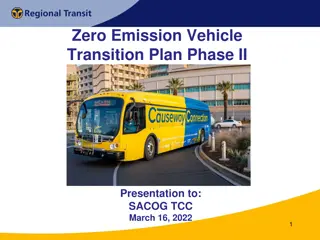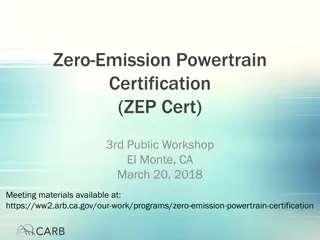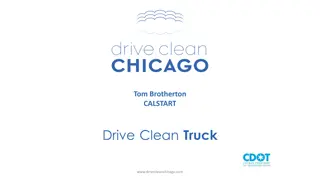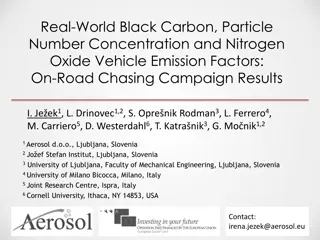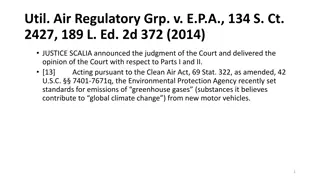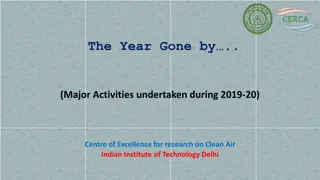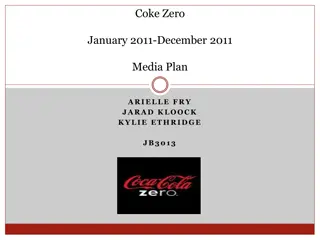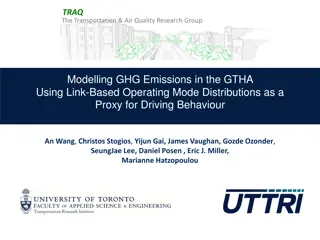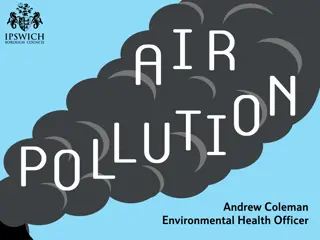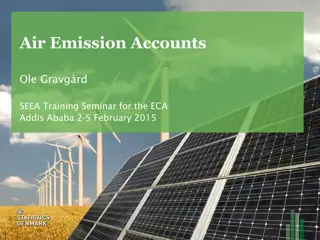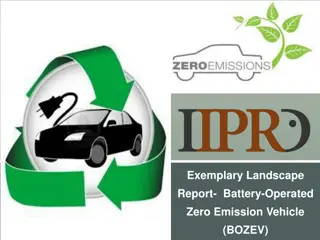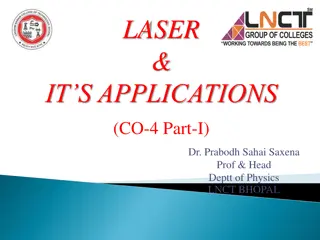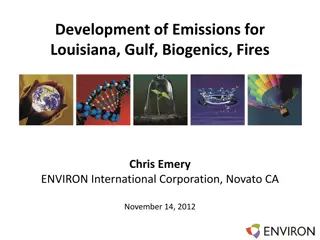Regional Zero Emission Vehicle Strategy for Clean Air Partnership
Exploring the importance of a Regional Zero Emission Vehicle (ZEV) Strategy for municipalities to mitigate infrastructure costs, reduce transportation fuel expenses, enhance economic development, and address environmental concerns. The strategy aims to promote the uptake of electric vehicles to combat poor air quality, reduce greenhouse gas emissions, and achieve long-term cost savings for local communities by leveraging policy levers and public awareness efforts.
Uploaded on Oct 03, 2024 | 0 Views
Download Presentation

Please find below an Image/Link to download the presentation.
The content on the website is provided AS IS for your information and personal use only. It may not be sold, licensed, or shared on other websites without obtaining consent from the author. Download presentation by click this link. If you encounter any issues during the download, it is possible that the publisher has removed the file from their server.
E N D
Presentation Transcript
Regional ZEV Strategy Clean Air Partnership November 7, 2019
Todays Discussion The Opportunity Why a Regional ZEV Strategy? ZEV Strategy Workplan Process for developing the strategy Toronto and Region Conservation Authority 2
Why a ZEV Strategy? Opportunity Statement Municipalities have an economic opportunity to encourage the uptake of EVs in their jurisdictions by mitigating infrastructure costs, reducing transportation fuel costs, securing energy spending on transportation fuels in the local region and by attracting economic development. Poor air quality from transportation emissions put residents at risk of premature death and chronic disease and contributes to municipal healthcare costs. Transportation is one of the top sources of greenhouse gas emissions in Peel and light-duty vehicles make up a significant portion. The IPCC indicates that the share of transportation from low-emission vehicles needs to be to 35%-65% by 2050 to limit global warming to 1.5oC (IPCC, 2018, C.2.4). A lack of EV charging infrastructure remains a particularly strong barrier, and municipalities have jurisdiction over policy levers that can encourage local development in ensuring long-term cost savings for local residents and businesses. Public and industry awareness and literacy around ZEV technology and its benefits remains low in the Canadian market (Plug'n Drive, 2018). Municipalities strong relationships with local communities positions them well to effectively raise awareness and educate residents and local businesses on emerging technologies. Toronto and Region Conservation Authority 4
Why a ZEV Strategy? The Market Context Rapid growth in global EV market Automakers have committed $300-$400B to make available over 200 plug-in vehicle models by 2022-2023 Personal vehicles in North America in the future will be larger, fewer and more electric. Many municipalities are prioritizing alternative modes of transportation to personal vehicles EVs are quickly being adopted worldwide Source: IEA 2018 Source: City of Vancouver, Transportation 2040: Moving Forward Toronto and Region Conservation Authority 5
Why a Regional ZEV Strategy? Transportation infrastructure crosses municipal boundaries Consistency for drivers as they travel through the region Charging station usage and pricing Consistent signage Regulations about preferred access to lanes or parking for ZEVs Commonpractices for development and construction industry Broader consistency of development policies Simplification of permit approval process Clarity on provincial versus municipal planning jurisdiction Evenlydispersed incentivization supports supply chain efficiencies Dealers focus EV vehicle sales in regions where customer are incentivized the strongest Cost-effectiveness from pooled resources Collaborative project of multiple organizations Toronto and Region Conservation Authority 6
Peel Climate Change Partnership Mandate: Working together to adapt to and mitigate the effects of climate change as we transition to a low carbon and resilient community within Peel Region Green Natural Infrastructure Strategy Low Carbon Communities Strategy Flood Resiliency Strategy Public Education Strategy Toronto and Region Conservation Authority 7
Governance Peel Climate Change Partnership Oversees all projects initiated under the banner of the Partnership Representatives Peel Commissioner Mississauga Commissioner Brampton Commissioner Caledon General Manager TRCA CEO CVC CAO Toronto and Region Conservation Authority 8
Governance ZEV Strategy Steering Committee Provides feedback on workplan, oversees project management, coordinates with municipal stakeholders Municipality Representatives Leya Barry, City of Mississauga Chun Liang, City of Brampton Katelyn McFadyen, Town of Caledon Adam Vaiya, Region of Peel Toronto and Region Conservation Authority 9
Governance Special Advisors Provides expertise on topics of key importance to the project s success. Electric Utility Representatives Daniel Carr, Alectra TBD, Hydro One Toronto and Region Conservation Authority 10
Governance Project Management Responsible for managing project tasks, producing deliverables, coordinating and managing third party vendors, facilitating meetings and updating ZEV Strategy Steering Committee at milestones. Project Management Team Nathaniel Magder, TRCA Gil Amdurski, TRCA Toronto and Region Conservation Authority 11
Strategy Elements Awareness and Education Infrastructure Social and Economic Opportunities Dreaming Big Toronto and Region Conservation Authority 13
Project Scope Vehicle types addressed In Scope: Zero emission vehicles Light-duty class: Cars, Trucks, Vans Owned by general public and businesses Not In Scope: Freight and heavy-duty Municipal fleet Transit Two-wheelers Toronto and Region Conservation Authority 14
Project Scope Vehicle types addressed AFV FCEV PHEV ICE BEV MHV Alternative Fuel Vehicle Fuel Cell Electric Vehicle Plug-in Hybrid Electric Vehicle Internal Combustion Engine Battery Electric Vehicle Mild Hybrid Vehicle Combustion engine using low-emission fuels (i.e. CNG or biofuels) Hydrogen is converted to electricity using a fuel cell Combustion engine and a battery improve fuel performance Powered by grid electricity alone Non plug-in hybrid vehicle Gasoline, diesel Zero-Emission Vehicle (ZEV) 15 Toronto and Region Conservation Authority
Workplan Existing Charging Infrastructure Mapping Stakeholder interviews and Secondary Research Report Synthesis ZEV Strategy Project Inception Policy Alignment Mapping Research and Data Analysis Action Prioritization Workshop Focus Groups Final Comment Period Strategy Synthesis Phase 1: Mapping Phase 2: Phase 3: Background Research Strategy Development WE ARE HERE Toronto and Region Conservation Authority 16
Policy Alignment Mapping Community Climate Change Action Plan Community Energy and Emissions Reduction Plan Transportation Master Plan Transportation Master Plan Smart Cities Master Plan Official Plan Environmental Master Plan Official Plan Parking Master Plan Official Plan Corporate Greenhouse Gas Reduction Framework Long Range Transportation Plan Climate Change Action Plan Transportation Master Plan Sustainable Transportation Strategy Goods Movement Strategic Plan Official Plan Alignment to ZEV Strategy Toronto and Region Conservation Authority 17
Municipal Stakeholder Meetings Departments included: Development Planning Economic Development Environment Public Health Transportation Planning Engineering Parking Authority Facilities Project Management Sustainability/Climate Change Toronto and Region Conservation Authority 18
Research Studies Research projects led by TRCA with support from partners Research Study #1 Community Surveys (x3 - Residents and Industry) Research Study #2 ZEV Adoption and Grid Impact Model Research Study #3 Socioeconomic Impact Analysis Toronto and Region Conservation Authority 19
Research Study #1 Research Study #1 Community Surveys Community Surveys The research will be divided into three (3) sub- projects: How aware are residents of ZEV technology and benefits? 1. Resident Survey What influences residents to purchase ZEVs? 2. Developers, Property Owners and Managers Survey How would residents respond to different types of municipal actions? 3. Commercial Fleet Manager Survey What are greatest barriers to industry installing charging infrastructure? What would the cost/benefit be to industry to install charging infrastructure? Toronto and Region Conservation Authority 20
Research Study #2 Research Study #2 ZEV Adoption and Grid Impact Model ZEV Adoption and Grid Impact Model 1. Region-specific ZEV uptake scenario by vehicle population How quickly will ZEV uptake occur in the region? 2. Region-specific ZEV uptake scenario by sub-region What charging infrastructure will be required? 3. A model of electricity grid demand from ZEV charging by sub-region How will the grid be impacted? How will certain actions affect this 4. A model of electricity grid constraint by sub-region uptake? Toronto and Region Conservation Authority 21
Research Study #3 Research Study #3 Socioeconomic Impact Analysis Socioeconomic Impact Analysis What is the projected economic impact of ZEV TCO to residents? What is the projected financial benefits of ZEV adoption to the municipalities? What employment risk and opportunities exist? What are the economic impacts from climate and health? Toronto and Region Conservation Authority 22
Workplan Existing Charging Infrastructure Mapping Stakeholder interviews and Secondary Research Report Synthesis ZEV Strategy Project Inception Policy Alignment Mapping Research and Data Analysis Action Prioritization Workshop Focus Groups Final Comment Period Strategy Synthesis Phase 1: Mapping Phase 2: Phase 3: Background Research Strategy Development WE ARE HERE Toronto and Region Conservation Authority 23
Nathaniel Magder Toronto and Region Conservation Authority, Community Outreach & Engagement nathaniel.magder@trca.ca Gil Amdurski Toronto and Region Conservation Authority, Community Outreach & Engagement gil.amdurski@trca.ca www.trca.ca


